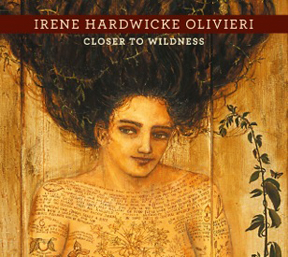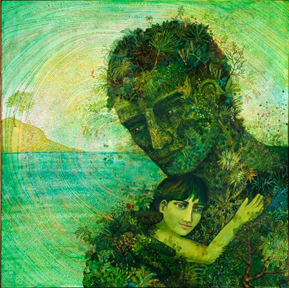A Conversation with Irene Hardwicke Olivieri
Many artists concern themselves with the tempo and vagaries of the art world. Others are directed by a singular inner vision and follow that path wherever it leads them. Irene Hardwicke Olivieri is one of those artists.
I first saw her work in a gallery in the East Village in Manhattan. I immediately connected to her unique imagery, which often has a woman as its centerpiece. The pictorial elements were combined with hand-printed text, which while clearly readable also yielded a multidimensional aspect. Like pointillism, the writing appeared one way up close while functioning differently from a distance.
When I delved into curating, I knew that eventually I would select Olivieri for one of my exhibits. Little House in My Heart was part of The Feminist Figure exhibit in 2005. It was at that time, while I was writing catalogue essays on each artist, that I first spoke with Olivieri.
This year, Olivieri has achieved two major milestones in her career. In addition to an exhibit at the Jordan Schnitzer Museum of Art in Oregon, she is the subject of a stunning monograph by Pomegranate entitled Irene Hardwicke Olivieri: Closer to Wildness.
The book has 140 full-color reproductions and is divided into eight sections—  comprised of topics that preoccupy Olivieri. These encompass portraits, stories, and nature. Each plate is accompanied by commentary written by Olivieri, yielding a combination of literate insights and visual sumptuousness.
comprised of topics that preoccupy Olivieri. These encompass portraits, stories, and nature. Each plate is accompanied by commentary written by Olivieri, yielding a combination of literate insights and visual sumptuousness.
With her new publication as a guide, I contacted Olivieri to revisit an overview of her work. We spoke in depth about her background, her influences, and the subtexts in her work.
Olivieri was born in South Texas, on the border of Mexico. She qualifies herself as being “a farmer’s daughter,” coming from a long line of farming people. This created the foundation for her connection to nature and the cyclic aspect of life. Olivieri spoke of the metaphor of a germinating seed paralleling how ideas germinate in her paintings.
Time in Brazil as an exchange student led to a return trip home along the path of the Amazon River. Olivieri stopped off in Guanajuato, Mexico to study art. After receiving a BFA from the University of Texas, Olivieri relocated to New York where she completed her Masters at New York University. She sought jobs that would “feed back into her work,” such as stints at the garden of the Cloisters and illustrating plants and insects for The New York Botanical Garden.
Olivieri related to me how she had to fight with professors in the early 80s, in order to freely explore her own pictorial vocabulary. Her next step, engaging with the Manhattan gallery system, yielded plenty of challenges. One gallery owner made a studio visit, perused her canvases, and informed her, “I don’t like the words in your paintings.” Picking out a depiction of a grasshopper, the gallerist proposed the possibility of a one-person show if Olivieri did ten versions of the grasshopper in different colors—with identical dimensions. Shortly afterwards, Olivieri connected with the Margaret Bodell Gallery, where her show garnered a review in the New York Times from Holland Cotter.
I spoke to Olivieri at length about her process. We discussed the integration of her text into the picture plane. She shared that there was no specific approach. Rather, it depended on the subject of the painting. When it’s related to the natural world, what she writes is the result of reading, note-taking and then restructuring the information through the prism of her own “thoughts and observations.” She said, “I’m writing as a reaction to what I’m learning and excited by.” Olivieri is aware that the text adds “another level of meaning to the piece,” and enjoys the evolutionary progression. Her material has ranged from descriptions of raising caterpillars to global aphrodisiac recipes. When the passages reference the emotional realm—such as “family secrets,” Olivieri told me, “The text happens organically. I’m feeling, thinking, painting.”
Olivieri identifies neither as a political or feminist artist, per se. However, her sensibility can be identified as within those spheres. Her diaristic approach to personal history such as a failed marriage or the death of a loved one are what Olivieri called, “emotional hurricanes that are fodder for my work.” She said, “My painting is intuitive in a visceral way.”
In Ten thousand kisses, Olivieri contemplates the “traditional” role of being a wife, evaluating her take on the experience. Painted in oil on a wooden rising bowl, it depicts her “internal struggle on finding a way to being a good wife.” At the feet of her doppelgänger is a devil girl—with ideas of her own. It should be noted that many of Olivieri’s surfaces are in the female domestic domain, such as wooden ironing boards, cutting boards, and bowls. Doors are also a favorite choice, and usually connect to imagery about transcending, evolving, or passing from one state of consciousness into another. She uses iconography that employs specifically feminine symbols, such as braids—which for Olivieri connote “the passage of time.”
Overtly socially conscious pieces do find their way into Olivieri’s oeuvre. Nature’s cleanup crew was a response to the failed leadership of Bush and Cheney. Olivieri explained, “It came from a place of passionate, almost impetuous, immediacy.” Here she riffs on the symbol of the vulture, as both a positive force in nature, and its use as negative linguistic terminology.
Her concern for the environment and the future of the planet is acutely palpable. Climbing the giant has a plaintive sensibility as Olivieri asks in her wording, “How can I paint about our beautiful and troubled world? How can I speak with my paintbrush? Help me in my simple way.” Yet by “bearing witness,” Olivieri is painting about the environment “as an antidote to the agony I feel about what is happening to it.” In Some kind of wilderness, the female figure embraces nature, while the background circular printing gives the names of new species that have been discovered in the past decade.
Olivieri’s fascination with science overlaps her art in the series made with animal bones regurgitated and removed from owl pellets. Combined with porcupine quills and shells, at first glance they could be woodcuts. Olivieri calls them “paleo mosaics.”
The visually rich output of Olivieri brings to mind a profusion of influences and associations: The art of Mexico, the meditative qualities of Tibetan art, devotional art, and Persian miniatures. There is even a nod to the complex narratives of Hieronymus Bosch.
Olivieri told me, “I feel lucky that I have a life where I get to be creative. I have always wanted to make art that connects on an experiential level…that is honest, unpretentious, and accessible to all.
It’s clear that she has achieved her goal.
Photos: Courtesy of Irene Hardwicke Olivieri
This article is from the series “Evolution of an Artist”








